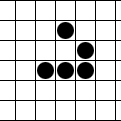Evolution by Conway
The "Evolution by Conway" or Game of Life, also known simply as Life, is a cellular automaton devised by the British mathematician John Horton Conway.
The universe of the Game of Life is an infinite two-dimensional orthogonal grid of square cells, each of which is in one of two possible states, alive or dead. Every cell interacts with its eight neighbours, which are the cells that are horizontally, vertically, or diagonally adjacent. At each step in time, the following transitions occur:
- Any live cell with fewer than two live neighbours dies, as if caused by under-population.
- Any live cell with two or three live neighbours lives on to the next generation.
- Any live cell with more than three live neighbours dies, as if by overcrowding.
- Any dead cell with exactly three live neighbours becomes a live cell, as if by reproduction.
See http://en.wikipedia.org/wiki/Conway's_Game_of_Life

The "Evolution" screen opens with "Evolution by Conway" item of "Misc." menu or by pressing Alt + \. With this configuration automatically creates random cells and start the process of their evolution.
The right-click in the "Evolution" screen invoces a popup menu containing the following items:
- Launch random (\ key) - generates random configuration ("population in the nest") with a given population density in the nest of a given size. Started the process of evolution at a given speed (parameter "Delay").
- Start/Stop (Space key) - stop / resume the process of evolution.
- Clear (Esc key) - cleaning of the entire field.
- -
- Delay - the value of the pause between cycles of evolution, can choose in the range of 1 to 500 milliseconds.
- Color
- Cell - color of cells
- Background - color of field
- The theme of "Ocean" - a predefined set the background color and cell.
- The theme of "Space" - the same.
- Cell size - you can choose from 1 to 8.
- The size of the nest - part of the field, which generates a random configuration - three options.
- Population density - given the likelihood of a "live" cells in the nest. Pick the experimental values of the size of the nest and population density for the most appropriate effect.
- -
- Load configuration ... - choose and upload an image file of configuration (there are some examples in the distribution, or your own), this configuration appears in the working area.
- Save Configuration ... - the image of the working field is stored in the file with the specified name.
It is possible to draw directly on a configuration screen. To do this, set the maximum size of a cell (if you do not wholly vision) and click by left mouse button at the desired point of the screen. The process of evolution must be stopped. You can click a mouse while the process of evolution too, but only for the destructive purpose.
You may use configuration published in Internet, see e.g.
http://fano.ics.uci.edu/ca/rules/b3s23/ or http://www.ericweisstein.com/encyclopedias/life/CoeShip.html
To do that:
- save desired image as file, e.g., "The Coe Ship.png",
- open it by, e.g., MS Windiws Paint, and recognize cell size in pixels
(15 for this example, intervals between the black blocks is taken into account),
- save the image as a monochrome BMP or GIF as e.g.
"The Coe Ship (15).gif" (in brackets indicates the size of the cell, if it is greater than one)
to "[ZET 9]\Conway" folder.